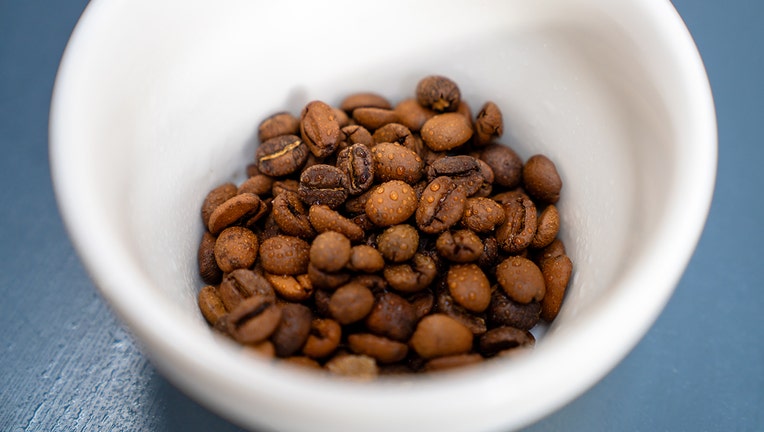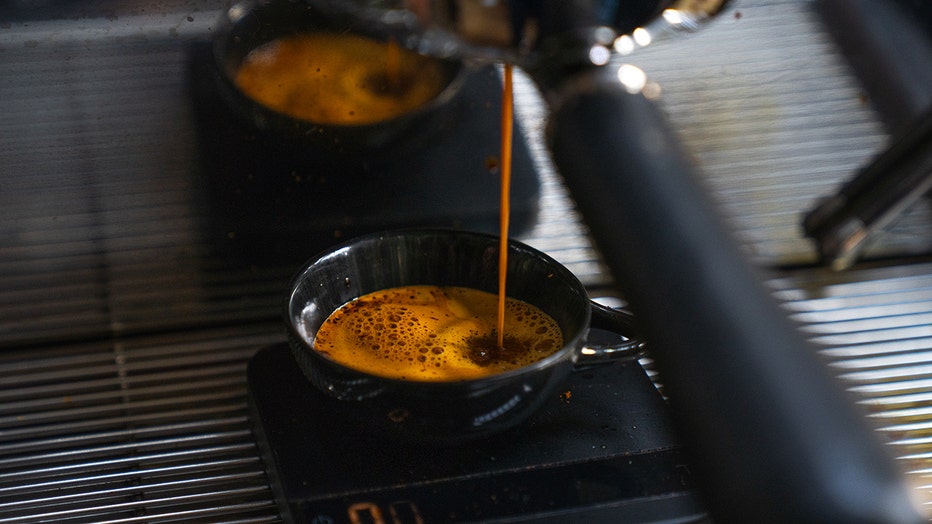Study suggests this ingredient leads to better coffee

Beans wet with 20 µL of water per gram of coffee. (Photo credit: University of Oregon)
EUGENE, Ore. - New research seems to confirm that a certain added ingredient during the process of brewing can lead to a tastier cup of espresso.
A new scientific paper, published on Dec. 6 in the journal Matter, studied the impact of adding a squirt of water before grinding coffee beans. The results show how doing so can significantly reduce the static electric charge on the grounds – leading to less clumping during brewing, and a more consistent and intense espresso.
RELATED: Costco rumored to be discontinuing sweet treat from food court
Some coffee baristas already add a squirt of water before grinding to cut static, which is an approach known as the "Ross droplet technique." However, no one had specifically measured the charge on coffee or explored how it might vary with different types of coffee, according to the researchers.

Scientists say coffee might be good for your bones
A recent study shows there may be a positive link between coffee consumption and bone health.
The idea for the research fittingly began over a cup of coffee.
University of Oregon chemist and study co-author Christopher Hendon, nicknamed "Dr. Coffee," hosts regular coffee hours for his lab at a local coffee bar. Volcanologists Josef Dufek and Josh Méndez Harper are frequent attendees, according to a release shared by the university.
The volcanologists began to notice similarities between coffee and the plumes of volcanic ash, magma and water that they usually study.
"It’s sort of like the start of a joke—a volcanologist and a coffee expert walk into a bar and then come out with a paper," Méndez Harper, a volcanologist at Portland State University and co-author of the new research, said in a statement.
"Coffee provides a nice platform to explore particle-scale physics that occur in volcanic plumes but are obviously very difficult to study directly in nature," Méndez Harper added.
While both coffee and volcanoes involve materials in different states of matter interacting with each other, coffee is a lot less dangerous than broiling hot ash and gas – and it’s much easier to study in a controlled way, Méndez Harper noted.
Adding water can lead to less coffee waste, tastier brew

Espresso mid flow. (Credit: University of Oregon)
Hendon’s team previously found in a 2020 paper that coffee forms microscopic clumps, particularly at fine grind levels.
The clumps mean water doesn’t touch every coffee ground evenly, leading to wasted coffee and cup-to-cup flavor variability.
For the latest paper, Hendon’s coffee lab sought to understand why those clumps form and how to eliminate them. The researchers suspected that static electricity might be the cause.
By collaborating with the volcanologists, Hendon’s team repurposed a tool that has been used to measure electric charges on wildfire and volcanic ash. The researchers ground coffee above a small metal instrument about the size of an espresso cup, and collected coffee particles falling into it.
Because particles are charged, they produce measurable currents when they enter the cup, the researchers said. The team tested several different coffee varieties, roasting levels and grind sizes to see how different variables made an impact on the charge.
Hendon’s team found that clumping was more of an issue in dark roast coffee, as these coffees tend to have less moisture since they’re roasted longer. Dark roasts also tended to have a negative charge, whereas lighter roasts — which have more residual moisture — acquired a positive charge, according to the team.
Adding a splash of water before grinding removed the static charge and reduced the clumping effects, the researchers found. It also got them 10% more yield from the coffee, according to the researchers.
The team noted how this could be a valuable strategy for baristas to waste less coffee, with fewer grounds getting stuck behind in the grinder, and the water moving through the packed grounds more evenly.
"Some baristas may have already anecdotally arrived at our conclusions; it's validating some industry know-how," Hendon said in a statement. "We are advocating for yet another step in producing excellent quality coffee, but it turns out you can’t cut corners if you want to achieve excellence."
Coffee and volcanoes brew explosive takeaways
The volcanologists also noted takeaways for their research on volcanoes. The way that particles break is one of the leading controls on eruption behavior, and grinding roasted coffee is a way to explore the physics of fracture, the team said.
Similar to coffee, volcanic ash particles can be highly charged – leading to volcanic lightning storms. It can also influence how long volcanic ash stays in the air and how far it travels after an eruption, according to the team.
And like coffee, water also plays an important role in volcanic eruptions.
"Explosive volcanoes have a lot of water vapor that helps drive and shape the eruptions," Dufek said.
"Ultimately, this project really shows the value of community efforts," Dufek added. "A coffee hour where people gather provides time and space to think about what's convergent with research."
The study was funded in part by the Department of Energy, the National Science Foundation, and NASA.
RELATED: These were America's top restaurants in 2023, according to Resy and Open Table
This story was reported from Cincinnati.

